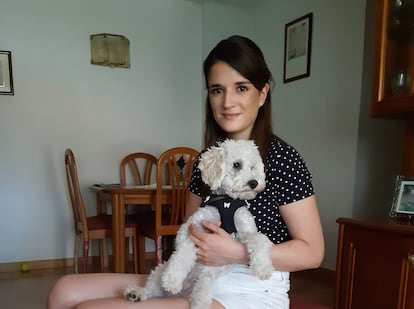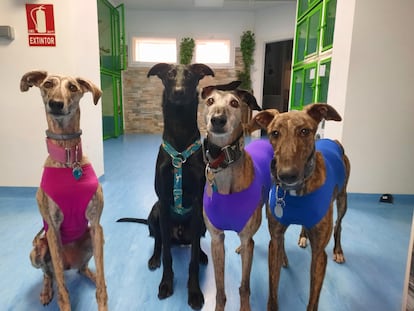Workers have gotten used to going back to the office. Their dogs haven’t
After months spending more time together than ever, pets and their owners must accept the return of face-to-face work. Some defend allowing them into the workplace

For Nuria Alonso, a 36-year-old administrative worker from Madrid, the return to face-to-face work meant the adoption of new routines. Instead of getting up at 7.30am, she set her alarm clock for 6am. She lengthened the brisk walk she took with Sugus, a nervous, fluffy poodle. She later created a complicated choreography intended to deceive the dog: Alonso locks herself in her room before the attentive gaze of the animal. Her mother then takes the dog into another room. Alonso takes advantage of his absence to sneak out of her bedroom, careful to close the door again, and she quietly leaves the house. “That way he thinks I’m still in my room and he stays calmer,” she explains over the phone. It is the only way, otherwise he spends the day crying and barking. Sugus’s is an extreme case, but it is far from unique.
It is called separation anxiety disorder, and it affects dogs that do not know how to deal with the absence of their owners. When the animal is left alone at home, it begins to cry or bark. Some break furniture, others pee on the carpet. This disorder usually affects puppies in their first months of life. It is more common in certain breeds, including Labrador, Border Collie and German Shepherd. But the pandemic has triggered the appearance of separation anxiety episodes in dogs of all breeds and ages.
Sugus is “a pandemic dog,” explains Alonso. He spent his first months of life in a house where someone was always around. In Spain, the dog population increased by 38% in quarantine, according to the National Association of Pet Food Manufacturers. A massive amount of animals has grown up in homes always full of people, normalizing what was once unusual.
At the Alonso house, confinement was strict. They only went out to walk the dog or to do grocery shopping once a week. Sugus was happy. Many dogs were. According to a study by Applied Animal Behavior Science, 65% of those surveyed indicated that their dogs experienced reduced stress during the pandemic, that they were happier and played more.
But the situation changed for Sugus. As his owners began to return to normal, he was left alone for longer and longer periods. At first he accepted it with resignation, but when Alonso returned to in-person work, he lost it. He started barking and whimpering every time he was left alone. His owner tried to solve it with a muzzle, leaving him in relatives’ houses, giving him prizes and treats. “I couldn’t even do the shopping in peace,” she laments. She finally went to a dog trainer.

The trainer, Carmen Martínez, believes that Sugus’s case is paradigmatic. “Teleworking has been a double-edged sword,” she explains. “In our society many dogs spend too many hours alone at home. This is a social species that tends to live in groups. Spending so many hours alone does not comply with their natural behavior patterns,” Martínez says. But the confinement and remote work made some people go to the opposite extreme. “They were accompanied for many hours, and when the people restarted their activities, the families began to have problems.”
That was not the case of Arancha Naranjo. The 38-year-old from Extremadura, in eastern Spain, combines teleworking with days at the office. She always does it next to Margot, a nine-year-old mutt. Her job, at the Bungalow25 advertising agency, allows dogs at the workplace. “Margot has never had separation anxiety,”, she explains in a telephone conversation, “but we work long hours and I don’t like for her to be alone for so long.”
Julio Gálvez, associate creative director of the company, also sees it that way, partly because he also has a dog, Yogi, who has a hard time staying home alone. He also understands that the policy retains workers and gives them a better quality of life. “Dogs are part of the family,” he says.
Each morning, Yogi and Margot arrive at the office, greet each other, make a round of caresses and lie down on their beds. Meanwhile, all around them, the clicking of keyboards, the beeping of notifications and whispered conversations create a familiar monotone hum. The dogs here are laid back. “I wish more companies were like this,” says Naranjo. “My dog is happier and so am I.”

Some tech companies, including Amazon, Google, Squarespace and Etsy, allowed dogs in offices even before the pandemic. Others have begun to do so in recent months as a way to retain their workers. But they are still rare in Spain. Naranjo knows that her case is an exception, but she believes it should be the rule. “I understand that a dog is not a baby, but I have encountered a lot of misunderstanding in other jobs where the hours were long and I couldn’t take Margot with me,” she says.
“It should be more common,” agrees Enric Rodríguez, an ethologist and author of a book on dog training. “Dogs, as companion animals and in some cases even assistance animals, do an important job in our society. It is time for us to adapt our lives to them.”
Another option, which is becoming more widespread, is to leave the dogs in daycare centers or to hire a walker to entertain the dog in the absence of its owners. Animal Solution, a Madrid pet nursery, confirms that there has been an increase in requests since the return to the new normal. “Nurseries have always existed, but in recent years the sector has become more professional,” says its owner, Luis Sousa, a veterinarian with more than 30 years of experience. They have room for just over a dozen dogs, and in recent months they have hung the No Vacancy sign several times.
Nuria Alonso has bought a digital camera that records the dog in her absence and transmits the image live to her mobile phone. “I look at it two or three times an hour,” she explains. Hers is a common solution. According to a study by PreciseSecurity, sales of this type of device have skyrocketed. They have been growing at a rate of 18.4% for years, and it is expected that by 2023 annual sales will exceed 300 million units.
Dog walkers, cameras, daycare, family help: these are the most common measures to address separation anxiety disorder, but all have failed in the case of Sugus. Alonso confesses that she is frustrated and hopes that the trainer’s help can tackle the problem. Hundreds of people are in the same situation: 26% of Spanish households have a dog, one of the highest percentages in Europe. The pandemic brought all these owners closer than ever to their dogs, but routine has separated them again. Now the workers are demanding measures to maintain their work-life balance. Many dogs, like Sugus, are also protesting in their own way.
Tu suscripción se está usando en otro dispositivo
¿Quieres añadir otro usuario a tu suscripción?
Si continúas leyendo en este dispositivo, no se podrá leer en el otro.
FlechaTu suscripción se está usando en otro dispositivo y solo puedes acceder a EL PAÍS desde un dispositivo a la vez.
Si quieres compartir tu cuenta, cambia tu suscripción a la modalidad Premium, así podrás añadir otro usuario. Cada uno accederá con su propia cuenta de email, lo que os permitirá personalizar vuestra experiencia en EL PAÍS.
¿Tienes una suscripción de empresa? Accede aquí para contratar más cuentas.
En el caso de no saber quién está usando tu cuenta, te recomendamos cambiar tu contraseña aquí.
Si decides continuar compartiendo tu cuenta, este mensaje se mostrará en tu dispositivo y en el de la otra persona que está usando tu cuenta de forma indefinida, afectando a tu experiencia de lectura. Puedes consultar aquí los términos y condiciones de la suscripción digital.
More information
Últimas noticias
Most viewed
- Sinaloa Cartel war is taking its toll on Los Chapitos
- Oona Chaplin: ‘I told James Cameron that I was living in a treehouse and starting a permaculture project with a friend’
- Reinhard Genzel, Nobel laureate in physics: ‘One-minute videos will never give you the truth’
- Why the price of coffee has skyrocketed: from Brazilian plantations to specialty coffee houses
- Silver prices are going crazy: This is what’s fueling the rally











































